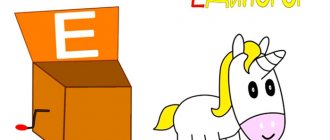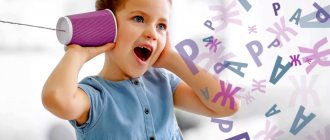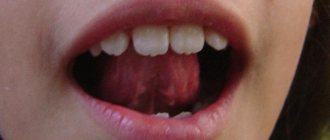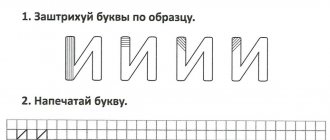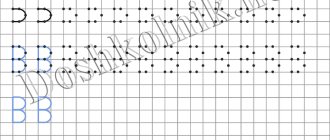Summary of a lesson on teaching literacy in a preparatory group. Sound and letter U
Sound U. Letter U. Lesson summary in the preparatory group of a preschool educational institution
Objectives: - consolidate the correct pronunciation of the sound U; - learn to hear and identify the sound U at the beginning, middle, end of a word; - introduce the concept of “vowel” sound; — introduce a new designation for the vowel sound (red)
;
- introduce the letter U; - learn to read the letter U; — teach the skills of sound-letter analysis and synthesis of syllables and words; - consolidate the correct agreement of the pronouns MY, MY, MY, MY with nouns; — consolidate the correct use of nouns in R. p., units. and many more number; - enrich the subject vocabulary with the sound U; - develop fine motor skills of the fingers; - develop spatial orientation on a plane; - develop memory, attention, thinking; Equipment: Toy duck, pictures with sound U (at the discretion of the teacher - in a strong, weak position; at the beginning, middle of a word)
- duck, ducks, goose, geese, rooster, roosters, fly, flies, chicken, hens, shark, watermelon , watermelons, moon, beetle, ears, bow, magnifying glass, hands, fishing rod, snail, knot, beehive, street, coal, circle, iron, spider, frog, sheepskin coat, whip;
individual speech therapy mirrors; picture of the articulation of the sound U; picture Steam locomotive - tu-tu; picture Steamboat - y - y - y; magnetic board; marker black, red; card letter U, card - picture “What the letter U looks like” - “The letter U is like ears, on the top of a bunny’s head”; wall ABC; wooden sticks for making the letter U; red cardboard squares; “Traffic lights” cards with chips to determine the place of a sound in a word; notebooks; pencils (plain, red)
.
Organizational moment Guessing riddles: I wake everyone up on time, even though I don’t wind the clock (Rooster)
;
The steamer floats back and forth, And behind it is such a smooth surface - Not a wrinkle can be seen (Iron)
;
He never offended anyone in the world, Well, why do both adults and children cry from him (Luk)
;
One hundred clothes and all without fasteners (Cabbage)
; What sound did we hear in the answers - the sound U;
Progress of the lesson
Phonetic gymnastics “Steam Locomotives - Steamboats” Our guest is Duck. The duck loves to swim in the river. Steamboats often pass along the river and hum - U - U. Sound like steamboats. And there is a bridge across the river. Steam locomotives often rush across the bridge. The locomotives are humming - Tu - Tu. The children sound like locomotives. We say it either quietly or loudly. Picture of articulation of sound U. Examination of articulation. Clarification of articulation. Children pronounce the sound U all together, then one at a time. Well done. Game “Name the Picture” Children name pictures with the sound U (at the discretion of the teacher)
, emphasizing the sound with their voice.
The game uses “Traffic Light” cards with chips to determine the place of the U sound in a word. Game “Greedy” The speech therapist lays out pictures in front of the children. He asks them to name them correctly. Then the participants in the game take turns covering any picture with their palm and saying: “My duck.” My iron. My geese, etc. The speech therapist monitors the correct completion of the task. Game “What is not” The speech therapist lays out pictures in front of the children. Asks them to name the word. Children check whether there is a U sound in a word. Then the teacher asks the children to name all the pictures in a row, remember them - take pictures with their eyes. And now the children close their eyes - the speech therapist removes one picture, asking: - What’s missing? We remove any one picture three times. We hide two pictures twice. Three pictures at once. Practicing the correct use of singular nouns. and many more numbers in R.p. Game “Catch the Sound” The speech therapist invites children to train their ears. As soon as you hear the sound U, catch the sound and clap your hands. In the game you can give words using the sounds U or I for comparison. Thus, preparing children to differentiate the sounds U - A or U - I. Example lexical material: iron, morning, duck, pineapple, rooster, puddle, powder, sheep, snake, mustache, doll, etc. Phys. minute Game “Ducks” The ducks are sitting in the nest (Children squat down.)
And they look around.
(Turns heads to the sides.)
They want to go for a walk, and they all fly quietly.
(The children scatter and wave their arms.)
They flew in, got tired, and returned back.
Ball games “Come on, repeat” Children stand in a circle, the speech therapist throws the ball to the child and asks him to repeat the sayings: - doo - doo - doo - children are running in the garden; - su - su - su - quietly in the forest in autumn; - woo - woo - woo - we saw an owl in the forest; - shu - shu - shu - waving a twig, etc. Game “Echo” The speech therapist asks the children to repeat rows of syllables - first loudly, then quietly: Tu - tu - doo Doo - doo - tu Pu - pu - bu Boo - bu - pu etc. Say the proverb: - Take a walk, but don’t forget your business; — I bought a pig in a poke; - A small deed is better than a big idleness; — Labor is not given in vain; - The fish is small, but the fish soup is sweet; - You can’t take a fish out of a pond without difficulty (explain the meaning)
.
Game “Riddles - Additions” Children add words to poems according to their meaning. - And the mountains are getting higher, and the mountains are getting steeper, And the mountains are going under the very ... (clouds)
;
- They gave us toys, They shot... (guns)
;
- At the edge of the forest, They will sing... (frogs)
;
- At the birch tree, in the morning, the Goat is gnawing with might and main... (bark)
;
- I wander the streets, I... (look at passers-by)
;
— I’m sitting in a new chair, a woolen sock... (knitting)
;
- I’m lying on the sofa, Sweet lollipop... (licking)
;
- I have a green one in my trouser pocket... (beetle)
;
- Bunny didn’t listen to dad, they crushed Bunny’s... (paw)
.
- It’s dark for us, we ask dad to turn on brighter... (lamp)
.
— What sound did you hear in the additions? (Sound U)
.
Letter U Showing the letter - card U. Finding and showing the letter U on the wall ABC. Showing the card “What the letter U looks like” - The letter U looks like ears, on the top of a bunny’s head. Writing the letter U in the air, writing the letter with your fingers on tactile cards - letters. The concept of “vowel” sound Children pronounce the sound U, while examining the articulation in the mirror. The sound U is a tube of lips, the mouth is open, there is no barrier. The sound is sung by voice. The sound U has no obstruction - it is a vowel sound. We will denote vowel sounds in red. The speech therapist draws a red circle under the letter U with a marker. Work in notebooks Children print the letter U in notebooks. A red circle is drawn under the letter U, while saying that the letter U stands for the sound U. The sound U has no barrier - it is a vowel sound. And the vowel sound is indicated in red. Summary of the lesson The speech therapist asks the children: - What sound did we play with today? The sound U has no barrier - what is the name of such a sound (vowel)
.
How do we denote a vowel sound? What letter denotes the sound U? (Letter U)
.
What does the letter U look like? (bunny ears, snail antennae)
. How do we write it? Well done boys.
We recommend watching:
Summary of a lesson on teaching literacy in a preparatory group with a presentation Summary of educational activities for children of senior preschool age. Preparing for literacy training Summary of a literacy lesson in the preparatory group. Letter Y Summary of a lesson on teaching literacy in the preparatory group. Sound and letter K
Similar articles:
Summary of GCD in the preparatory group for literacy training
Summary of the speech therapy lesson “Sound [U], letter “U”
Speech therapy session summary
“Sound [U], letter “U”
GOAL: To give children the concept of the vowel sound “U”. Clarify its articulation. Strengthen the skills of clearly pronouncing the sound “U”. learn to isolate the sound “U” from a number of vowels. Introduce the graphic designation of the sound “U”. Introduce the letter U. Teach how to correlate the sound and the letter. Develop sustained attention in class.
EQUIPMENT: individual mirrors, object pictures with the sound “U”, cash register of letters.
PROGRESS OF THE CLASS.
1. Organizational moment. I'll tell the children:
Stand up nicely and listen to whoever can sit down (I give instructions in a low voice, maximum attention is required from children).
- Sasha, sit down. Maxim, sit down. All boys, sit down. All girls, sit down.
2. Tell the children: Today you will learn to pronounce the sound “U” well and become familiar with the letter “U”.
Pronunciation of the sound "U". suggest pronouncing the sound “U” quietly and in a voice of normal volume. Examine and describe the articulation of sound in the mirror.
The lips are like a tube, the teeth do not close, they are closed with the lips.
Children pronounce the sound well and one at a time.
— Look, the air stream comes out through the “Tube” freely, there is no obstacle. We can draw out the sound “U” with our voice for a long time, sing. Therefore, it is called a vowel, from the word “voice”, “voice”.
Air flows freely through the mouth,
There are no different obstacles.
The voice participates, the voice sings.
The sound is vowel.
- Let's denote it with a red square.
3. Game "Magic Wand".
“Repeat after me the one I touch with the pointer.” Children clearly repeat the syllables.
tu mu uh uh uh uh uh
lu ut ru um chu su ku, etc.
4. Now let’s check who is the most attentive - the game “Telegraph”. I'll say the text. It should be remembered by telegraph. Who is the most capable? Listen:
Mu - tu mind - us gu - well
Ut - uk su - fu us - ut
5. Game "Signalers".
Children have red sound flashlights in their hands. Hearing the sound “U”, the children raise their lanterns. Sound selection:
a) from a number of vowel sounds: a, o, u, i, u...;
b) from the syllables: uh, up, os, um….
6. Pronunciation of words with the sound “U”. Isolating “U” from the beginning of words.
a) Show the picture “Duck” - children name and identify the sound “U”.
I’ll name three more words: ear, Ulya, ears - let’s define the first sound “U”, repeat the words all together, emphasizing the sound “U” intonationally.
then the children independently name pictures with the sound “U” at the beginning of the word. (they are displayed with others on the board).
-What is the first sound we pronounce in these words? The sound “U” is at the beginning of the word, let’s designate its place on the diagram of the word:
duck snakes street
snail iron duckling
ears mustache teacher
b) Pronouncing words with the sound “U” in the middle of the word: I will say the names of the pictures remaining on the board:
Target.Teach children to analyze a sound series consisting of two vowel sounds; introduce the letter Uy; exercise the ability to navigate the plane of a sheet (directions: top to bottom and bottom to top).
Equipment.
A set of pictures, a plot picture, a panel of letters; sheets of paper with flowers drawn below and paper bees (according to the number of children).
Preliminary work.
Children draw flowers on individual sheets (at the bottom of the sheet).
Progress of the lesson
1. 1. The teacher tells a story, emphasizing the sound [u] in his voice:
- Today I will tell you about a little bee. Her name was Ulya. One early morning Ulya flew out of the hive house. She flew to the meadow beyond the distant forest to collect honey. Ulya hummed cheerfully:
Ooh-ooh, ooh-ooh
I'll collect a lot of honey!
Near the pond, Ulya saw a duck. Mother duck taught ducklings to swim. Ulya flew on. She looks at her friend crawling on a pebble. “Good morning, really!” - “Good morning, Ulya!” The bee flew on, singing:
Ooh-ooh, ooh-ooh
I’ll collect honey for everyone!
2. - What song did Ulya sing? (oo-oo-oo) The bee's song is similar to the sound [u]. Remember the words with the sound [u] from the story about the bee Ulya (if the children cannot remember, the teacher asks leading questions).
- What sound do these words begin with? ([y]). Highlight this sound in words with your voice.
3. Articulation of sound. When pronouncing a sound [y], the lips are in the shape of a tube, the tongue lies behind the lower teeth, the air passes calmly and smoothly, without encountering an obstacle in its path, the sound is pronounced with the voice (the vocal cords vibrate).
Characteristics of sound.
— What do we call sounds that are pronounced with the voice and do not meet obstacles in the mouth? (Vowel sounds) So the sound [y] is a vowel.
II. 1. — While flying through the forest, Ulya heard someone shouting: “Ay!” This girl is lost. Ulya tells her:
Oooh. uh-uh.
Follow me, I'll take you out.
Ulya took the girl out of the dense forest and brought her all the way to the house. The girl had a little brother. The baby cried: “Wa-wa!” The bee left him honey. And she flew on.
The teacher invites the children to remember how the lost girl screamed in the forest (ay) and the crying baby in the crib (wa).
- How many sounds do you hear in a word? (The teacher sings a-a-a-u-u-u, then u-u-u-a-a-a) What is the first sound in a word? What's the second sound? What sounds are these? (Vowels)
Working with the sound house.
2. The teacher suggests remembering and repeating Uli’s songs.
III. 1. Getting to know the image of a letter.
The teacher shows a card with a picture of the letter Uu. The letter moves into the apartment on the letter panel at the address: sixth floor (topmost row), apartment No. 2.
— The letter Uu lives next to the letter Aa. They are neighbors in our house.
2. Analytical and synthetic activities. (Similar to lesson 3)
IV. Exercise “Bee in the meadow” to develop orientation on a sheet of paper and reinforce the direction from top to bottom and bottom to top.
The teacher gives the children their sheets with painted flowers and paper bees.
- Finally, Ulya the bee flew to the meadow. (Children place the bees at the top of the sheet) A bee flies and looks down. So many beautiful flowers. The bee began to sit on the flowers and collect nectar. It will sit on one flower, then rise into the air again. And he sits down again. And it will rise again.
-Where is the bee? (Above) Where do flowers grow? (Below) When a bee lands on a flower, how does it fly? (Top to bottom) And when does it rise from the flower? (Bottom to top) Show how a bee flies.
Children follow the teacher’s instructions, moving the bees along the sheet and accompanying the actions with the appropriate words: top to bottom, bottom to top, etc.
